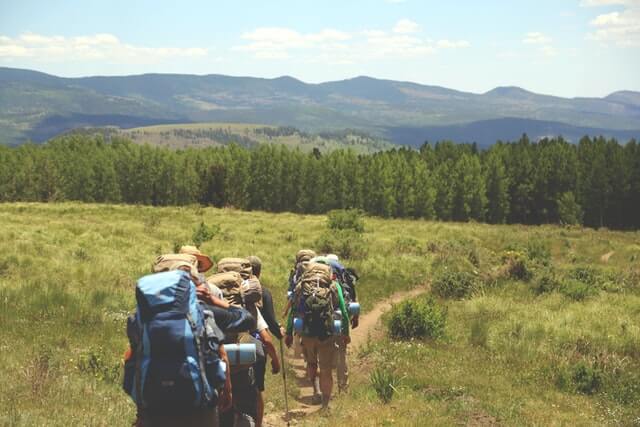Hiking is a great way to enjoy the great outdoors, however many people make the same mistake over and over: going on a hike without some training before. The result: sore legs muscles, getting very tired throughout the expedition, and sometimes ending with disliking this activity. One of the best ways to avoid this is by trying out some special workouts for hiking.
Most likely not even the experienced hikers do them, but their bodies are more used to the demands of such an experience. These workout routines are meant to get your leg muscles used to prolonged walking, climbing, and even stretching. Your arms and back also need some preparation for you’ll also use them quite a lot.
This article will present you some easy exercises you can try out, as well as instructing you how to perform them. You can choose to practice them even if you don’t plan on going on a hike or a backpacking trip as they will help with maintaining a fit physique or even lose a few pounds. We’re sure that once you’ll try these sessions out, and go on a hike, your opinion will change.
Train in advance for best results
Many people are scared of going on a hike because of the soreness they experience after. These people most likely think that seasoned hikers don’t get sore muscles, or as tired – and this is true because they’re used to the effort. Most of the population though, go on a hike just once in awhile.
Age appropriate routines
If you want to know how to get in shape for hiking, you should first learn there are more routines to try out. Most of them are adapted for various age groups since the body requires different type of training at different stages in life.
What you need to know is that the age groups are 18-35, 35-50, 50-65 and over 65. The drills presented here are most fit for people between ages 18 and 35, with a stretch to 50. Collecting exercise sessions for each age would make this article a bit too long and boring.
What body part do I train more?
This is a very good question, and the answer depends on your age, experience as hiker, as well as the difficulty of the trail. It should go without saying that those who never hiked before should start off with easy trails and stay away from the difficult ones. Furthermore, those with a more advanced age should also avoid the difficult hikes.
Must read: Which Exercises Help Prepare For Uphill Hiking? Your Guide To Blazing Trail
What all age groups should train though, is their legs and backs as these will be used the most. Older folks might find it useful to toughen their backs more, though their legs need just as much attention. Younger hikers should probably focus more on their legs, though their backs should not be ignored.
However your arms and your heart also need some preparation. Your arms need some strength just in case you’ll have to climb over various obstacles. Luckily, your heart gets trained indirectly, as you work out the other muscles.
Start as early as you can
As mentioned throughout this article, for the best results you’re supposed to start preparing some three weeks in advance, at the very least. The first thing you’re supposed to do is to make sure you buy appropriate clothes and shoes and to train in them to ensure the comfort level is the desired one. You really don’t want to walk around with blistered feet or feeling too hot or too cold.
An early start allows you to built enough strength, increase your endurance, and heal both sore muscles and blisters – should they happen. This preparation will also allow you to better enjoy your surroundings and generally have more fun. You should also consider training more if you’re an absolute beginner at hiking.
Don’t forget the mental preparation
It is possible that some folks end with disliking Mother Nature because they didn’t go out there being mentally prepared. This includes doing research on things like the weather, altitude, how much food to bring, or what type of clothes.
For some, the biggest challenge has to do with having to use the bush instead of a traditional comfortable toilet. Not everyone is mentally ready for this situation, but natural bodily functions cannot be ignored. Doing a little bit of research will ease this process.
Another aspect not to ignore is the sleeping part, should the expedition last for a few days. Are you OK with sleeping on the ground, with bugs singing and walking close to you? So the real question here is just how much of your comfort are you willing to sacrifice for the sake of experiencing something new.
How to train
The most recommended way is to break down your routine, however this will only work if your trip is let’s say, still 3 months away. You’ll need your calendar as well, to mark down the dates and routines. You’ll need 3 cycles lasting 4 weeks each.
During your first 3 weeks your heart rate should be maintained between 55% and 65% of the maximum. You’ll want to train longer and longer every week, but make sure to back down during the 4th week. In the second cycle, increase your heart rate to not more than 75%, as well as increasing the mileage.
The last cycle, make sure to carry more weight, further increase your mileage, and trail difficulty. Don’t forget to have the 4th week of the 3rd cycle as a resting period. Lastly, to avoid injuries the intensity of your training cannot be increased by 10% each week.
But enough talking, and let’s see some workouts that will make the whole thing easier at least in one way. There is one thing you must not forget: you must always warm up before working out as to avoid injuries, and before the hike itself to remind your muscles they’re about to work harder.
Exercises for hiking to keep soreness at bay
These are some of the best routines to try if you want a better endurance during your trip, and to reduce the muscle soreness of the day after. You should be warned to start working out at least 2 weeks before, but 3 weeks before is even better.
Stepping – on and off things
What you’ll need: A short flight of stairs, or a small object on which you can climb, without it breaking
What will you do: Simply climb up and down of the chosen item
You can intensify your workout routine by carrying a backpack as well, just like you would in nature. The very act of carrying something on your back will tire you further in nature, and you’ll need to prepare yourself. You’ll also avoid unwanted back pains through training this way.
You don’t really have to spent money if you live in an apartment building or if you have a flight of stairs in your house. All you have to do is to take the stairs every time you go out and return home. If the stairs are in your home, go up and down a few times every day for two weeks or so, before the trip.
If you use a box, the routine is a bit different. While standing on it, bend one knee and pretend you’re climbing down with the other leg, just until you can feel the floor. At that point push back up in the starting position. You’ll do 3 sets of 15 for each leg, per day.
How is it useful: Your muscles will get used to an intensive and repetitive movement in a short period of time. Going uphill uses different muscle groups and a different body posture than when going downhill. The more you train those specific muscles before the trip, the easier the hike will be.
Downhill lunges
What you’ll need: A 30 lbs backpack, a gradual slope, appropriate footwear
What will you do: Jump downhill
This routine is an alternative to the previous one, and is especially good if your living conditions are not as needed above. Furthermore, nature lovers will most likely be happy about this alternative. This workout is not really recommended to those with bad knees and ankles, as the risk of injury is quite big.
Having said that, it doesn’t mean you should not try this out if your joints are bad. Instead of jumping, you could be walking downhill. Regardless of how you decide to perform this training session, make sure you do it 3 times a day, and 3 days per week.
Additionally, make sure not to surpass a distance bigger than 50 yards. The best time to start it, is 3 weeks ahead of your adventure. Paying attention to your footwear is vital at this point, as you need to make sure your shoes will hold and offer proper support without injuring you.
How is it useful: As mentioned before, this workout will prepare your thighs for the descents, or better said, the return way.
The chair walk
What you’ll need: An office chair with wheels and some free space
What will you do: Sit on its edge, and walk while sitting
You must be careful as to sit on the front half of the chair while maintaining a very straight back. To help with the position, place your hands behind your head. You should be walking over a distance of 75 feet, one way and then back to the start point. You’ll also have to repeat 3 times per day.
Most likely many of you readers don’t have a free 75 feet straight line to try this exercise on. That’s not something that should stop you though: just measure your space and do as many rounds as needed, to fulfill the goal.
How is it useful: This strange routine will strengthen your hamstrings which are generally overworked during a hike. You’ll most likely be impressed to notice other positive results.
The ragdoll pose
What you’ll need: A few free minutes
What will you do: Bend over, forward
This routine is as easy as it sounds, and while it might not make you very tired, it could make you dizzy. This is in fact a very easy Yoga pose: all you have to do is keep your legs together and bend forward as much as you can. Your hands must hang freely and your torso must be relaxed.
You’re supposed to maintain the pose for up to 30 seconds. This is done before you start the hike of the day, just once. Consider it as part of a stretching routine that should be always done at that point.
How is it useful: Other than being part of a warm up, this pose will work your hamstring muscles. This pose will minimize the risk of straining those muscles during the expedition.
Side skips
What you’ll need: Some free space, preferably outdoors
What will you do: Jumping sideways
To better understand this routine, you should probably also watch some soccer games, and better yet the beginning part when the players warm up. They jump sideways, starting in a standing position with their legs close together and arms to their side.
They take a step to the side with one foot, then they skip, and while in midair they bring their other leg close to the one they started with. The landing happens on the second foot, and then another such movement is done. This side skipping should happen over a distance of 50 yards, and then one must return to the starting point while skipping with the opposite leg first.
See also: Ankle Strengthening: Steps to Improve the Strength and Stability of Your Ankle
Some people might be scared of this side movement, but it is a rather easy one to perform. If you wish, you could just walk the distance, on a side, though the results might not be the same.
How is it useful: This exercise will train your inner and outer thigh muscles, a groups of muscles that you might not think are being used during a hike. In fact, you might be forced to make multiple side movements as well, and you’d better be prepared.
Yoga pose – the Warrior
What you’ll need: Some space and a bit of time
What will you do: Stand in this position for some seconds
The Warrior II is a rather easy yoga pose that almost anyone can do without much training, though some warming up is required. Start in a standing position while your legs are some 4 feet apart and your arms stretched out sideways, with the palms down. Next, turn your right foot in and the left one out, so that together they form a 90 degrees angle.
The next step is to flex your left knee so that it will be right above the foot. Your shin will form a 90 degrees angle with the floor. You must turn your face over your left shoulder as much as possible as well. You must hold this pose for at least 30 seconds and then return the initial position, and then repeat on the other side.
How is it useful: There are many benefits that come from this yoga pose. Not only with your thigh muscles will become stronger, but your flexibility and equilibrium will also improve. Aligning your knees and opening your hips are other positive and useful results you’ll notice.
Walking or hiking
What you’ll need: Time, purpose, some weight
What will you do: Simply walk the distance
It is highly possible that you have a full time job as well as many other obligations to attend to, so hiking might not be something you can do during the week unlike the other routines. Instead, you could walk from home to your office, or at least part of the distance. You can save one day per weekend to go for a more serious hike in the park.
A faster alternative would be to rid your bicycle to work. It might not seem like much, but your legs muscles will get some workout out of that.
How is it useful: Just like the athletes that train for the marathon by running, the same you train for a hike by walking or hiking. You will seriously not need to go to the gym if you turn this into a routine. To find out why hiking is such a a complete lower body workout, check out our article on this topic.
Final thoughts
We finally reached the end of this guidelines. Remember these exercises are supposed to help you out for your upcoming hiking trip, especially if you’re a beginner. At first you might not be aware of the benefits of working out, especially for hiking, backpacking, or even camping.
Perhaps you won’t see seasoned hikers or guides working out, and they might not even think about recommending training to their trip companions. This might be due to the fact that their bodies are already used to the effort of a hike.
Featured Image Source: https://unsplash.com/photos/juHayWuaaoQ





